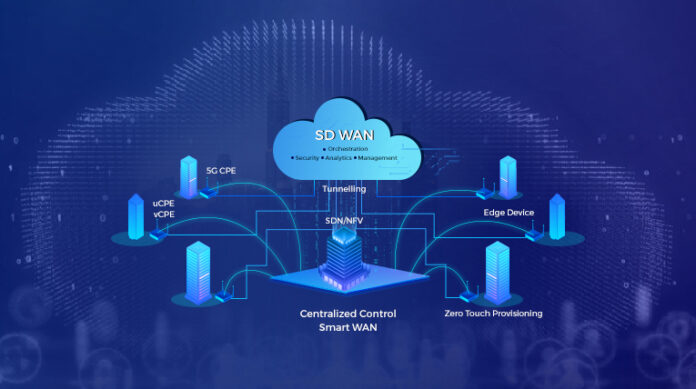The traditional network architectures for business connectivity require costly backhauls to access cloud applications. These models also have a high management overhead.
SD-WAN converges the WAN edge, global backbone, and full network security stack into a unified cloud-native platform. This simplifies the entire WAN transformation journey.
A basic SD-WAN solution steers traffic based on pre-defined rules programmed via templates. However, a business-driven SD-WAN automatically adapts to changes like network congestion and transport outages with continuous self-learning.
Enhanced Security
As more employees work remotely, secure connectivity that provides reliable, high-performance, cloud-based services and applications become increasingly critical. SD-WAN allows it to do just that with a range of programmable network devices and dynamic best-path routing that improves cost, agility, and performance.
A business-driven SD-WAN will intelligently steer traffic based on policies aligned with your business goals while continuously measuring WAN performance to avoid application degradation. It will also automatically detect and respond to performance issues such as latency and packet loss with minimal manual intervention.
The basics of SD-WAN can help protect your data from security breaches by generating backup information, called parity, that travels with data packets over the WAN. This helps to repair any lost or corrupted data that might occur during transmission. It can also offer additional security capabilities like a Web gateway that supports zero-trust access, remote browser isolation, and encryption/decryption.
Enhanced Flexibility
An SD-WAN is an excellent solution to upgrade your network’s performance and security without investing in new hardware. A software-based network allows you to change networking policies at the centralized level and push those changes to remote sites over encrypted tunnels.
With traditional networking solutions like MPLS, traffic created in branch offices is backhauled to a data center at headquarters. This introduces latency and impairs application performance. SD-WAN enables traffic routed using the best real-time path by leveraging different transport methods, including xDSL, cable, 5G, and more. It also allows link-bonding by combining multiple Internet links, avoiding the trombone effect and improving last-mile bandwidth.
In addition, SD-WAN can provide application optimization that prioritizes business-critical applications and improves their performance over low-priority traffic. This ensures that your employees won’t experience slowdowns and disruption to their work if their internet connection fails.
Enhanced Efficiency
SD-WAN reduces costs by leveraging cost-effective network access types such as broadband Internet, MPLS, and wireless to connect branch offices and remote workers. It also enables enterprises to use cloud apps/services and simplify the management of their private networks. In addition, it offers a way to secure connectivity and help eliminate data center bottlenecks.
Unlike traditional tunnel-based network technologies, which add overhead through headers that consume precious bandwidth, SD-WAN uses application-aware policies that create WAN connections that are much more efficient. WAN optimization capabilities that reduce latency, jitter, and packet loss enable companies to optimize their telecom costs at the application level.
Moreover, it can handle transport outages without disrupting business operations by leveraging multiple redundant links. It can also automatically detect a loss of a single connection and reroute traffic to a different link based on policy and performance criteria.
Enhanced Scalability
Application performance is critical to business productivity, customer satisfaction, and profitability. SD-WAN enables greater consistency and performance at application touchpoints across the enterprise.
Traditional WANs backhaul traffic to centralized data centers, which can introduce latency and impair application performance. With SD-WAN, application optimization identifies which applications are sensitive to latency and packet loss and routes them over a more reliable link.
SD-WAN’s ability to leverage multiple network connections, including existing MPLS circuits, broadband Internet, and 4G/LTE, reduces costs and improves last-mile bandwidth and redundancy. This flexibility also provides centralized management that’s easier than managing individual gateways and routers.
Adding an Internet backup also makes connecting to popular cloud platforms like Salesforce, Office 365, and Dropbox easy. This enables employees to work from home, on the road, or in other locations without losing access to their needed apps. This increased mobility can result in higher employee productivity, better business outcomes, and lower security risks.
Enhanced Reliability
SD-WAN uses business-driven policies to intelligently steer application traffic over the most reliable link, avoiding performance degradation from jitter, latency, and packet loss. The result is a more stable network for remote workers and customers.
It’s also cheaper to use SD-WAN than MPLS. That’s because it allows businesses to leverage more affordable broadband internet connections rather than costly MPLS circuits.
With zero-touch provisioning, SD-WAN devices connect to a cloud service provider’s point of presence and automatically configure themselves. It doesn’t need to worry about deploying the correct configurations for each location, which can be complicated and expensive. Instead, changes to structures, fixes, and policies can be programmed centrally and instantly pushed out to each site. That’s a much quicker, simpler, and more efficient way to create a more intelligent, resilient network. And it also helps cut costs by eliminating the need for hardware at each site.
Enhanced Flexibility
As companies connect remote workers and cloud resources, they need a flexible network. SD-WAN enables them to quickly scale and easily manage connections from branch offices and data centers. It delivers flexibility for work-from-home, campus, and cloud connectivity while improving performance, efficiency, and security in a digital business environment.
SD-WAN provides a more dynamic connection between branches and core networks by choosing the best route for application traffic based on real-time monitoring. Using probes to measure latency, jitter, and packet loss, traffic is moved over the best link for optimal performance. This also reduces network downtime in the event of a single link failure.
An SD-WAN solution also saves IT costs by enabling the use of cheaper broadband internet or LTE links. It improves reliability by incorporating MPLS and Internet backup to eliminate single points of failure or link bonding that combines multiple links for improved last-mile bandwidth.











